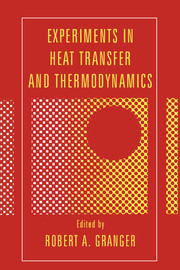Book contents
- Frontmatter
- Contents
- Preface
- Introduction
- Part I Experiments in heat transfer
- I.1 Conduction
- I.2 Convection
- Experiment 7 A forced convection heat-transfer experiment
- Experiment 8 Reynolds analogy for mass transfer
- Experiment 9 Natural-convection melting of a slab of ice
- Experiment 10 Forced-convection heat loss from 3D solids
- Experiment 11 Forced and free convective heat transfer of a laminar flow in a horizontal heated pipe
- Experiment 12 Measurement of convective heat-transfer coefficients on external surfaces
- Experiment 13 Measurement of local heat-transfer coefficient on the ice surface around isothermally cooled cylinders arranged in a line
- Experiment 14 Experiments of unsteady forced convection in ducts with timewise variation of inlet temperature
- Experiment 15 Measurement of heat and mass transfer from a body in air–water mist flow
- Experiment 16 Measurement of transient/steady heat-transfer coefficient with simultaneous photography of flow processes from beneath the heater surface
- I.3 Boiling
- I.4 Mixing, dispersion, and diffusion
- I.5 Radiation
- I.6 Heat pipes and exchangers
- Part II Experiments in thermodynamics
- Appendix 1 Experiments and demonstrations in thermodynamics
- Appendix 2 Experiments and demonstrations in heat transfer
- Appendix 3 Heat-transfer and thermodynamic films
- Index
Experiment 15 - Measurement of heat and mass transfer from a body in air–water mist flow
Published online by Cambridge University Press: 05 June 2012
- Frontmatter
- Contents
- Preface
- Introduction
- Part I Experiments in heat transfer
- I.1 Conduction
- I.2 Convection
- Experiment 7 A forced convection heat-transfer experiment
- Experiment 8 Reynolds analogy for mass transfer
- Experiment 9 Natural-convection melting of a slab of ice
- Experiment 10 Forced-convection heat loss from 3D solids
- Experiment 11 Forced and free convective heat transfer of a laminar flow in a horizontal heated pipe
- Experiment 12 Measurement of convective heat-transfer coefficients on external surfaces
- Experiment 13 Measurement of local heat-transfer coefficient on the ice surface around isothermally cooled cylinders arranged in a line
- Experiment 14 Experiments of unsteady forced convection in ducts with timewise variation of inlet temperature
- Experiment 15 Measurement of heat and mass transfer from a body in air–water mist flow
- Experiment 16 Measurement of transient/steady heat-transfer coefficient with simultaneous photography of flow processes from beneath the heater surface
- I.3 Boiling
- I.4 Mixing, dispersion, and diffusion
- I.5 Radiation
- I.6 Heat pipes and exchangers
- Part II Experiments in thermodynamics
- Appendix 1 Experiments and demonstrations in thermodynamics
- Appendix 2 Experiments and demonstrations in heat transfer
- Appendix 3 Heat-transfer and thermodynamic films
- Index
Summary
Principle
By suspending a small quantity of water droplets in a gas stream, convective cooling of heated bodies is remarkably improved in comparison with singlephase gas cooling.
Object
This experiment demonstrates how convective heat transfer can be enhanced due to the evaporation of a thin water film, maintained on a heated surface by continuous impingement of water droplets, and the sensible-heat cooling by droplet impingement. The enhancement of heat transfer is governed by the temperatures of the air–water mist and a heated body, air-stream velocity, water-to-air mass flow ratio, size and spatial distribution of water droplets, wet-area fraction of the body surface, and so on.
Apparatus
The outlines of the air–water mist flow tunnels to be used for the heattransfer experiments are illustrated in Figs. 15.1 and 15.2. Figure 15.1 shows a test tunnel of the open type for horizontal air–water mist flow;5 Fig. 15.2 shows a test tunnel of the circulation type for vertical air–water mist flow.2 In the test tunnel shown in Fig. 15.1, pressurized water is sprayed through ten hollow-cone spray nozzles which are arranged in a circle around the centerline of the spray chamber. The additional use of a flat spray nozzle is recommended to humidify and saturate the carrier air. It is better to locate these nozzles sufficiently upstream so that drops larger than the desired ones may settle out of the mist in the low-velocity spray chamber.
- Type
- Chapter
- Information
- Experiments in Heat Transfer and Thermodynamics , pp. 99 - 111Publisher: Cambridge University PressPrint publication year: 1994



